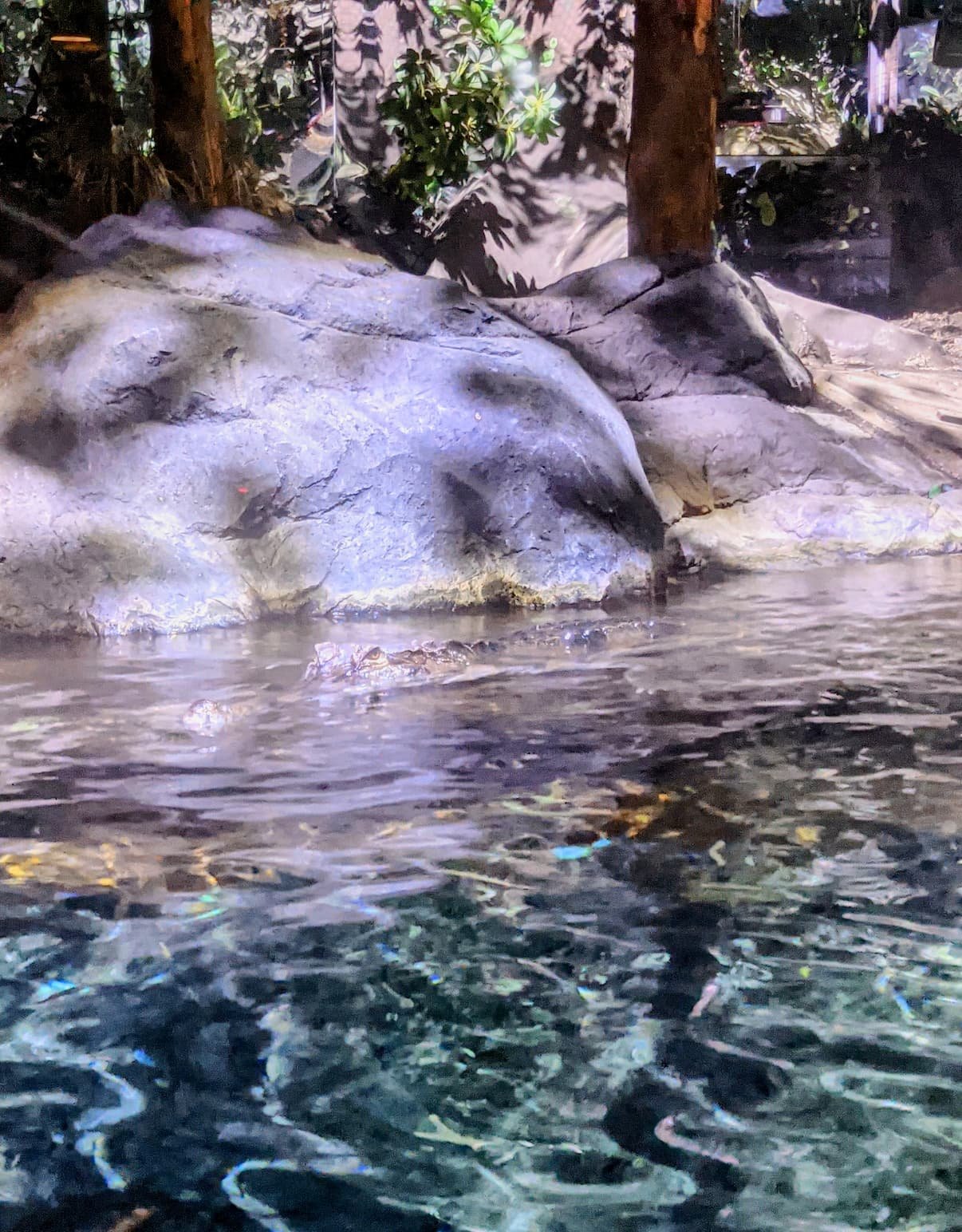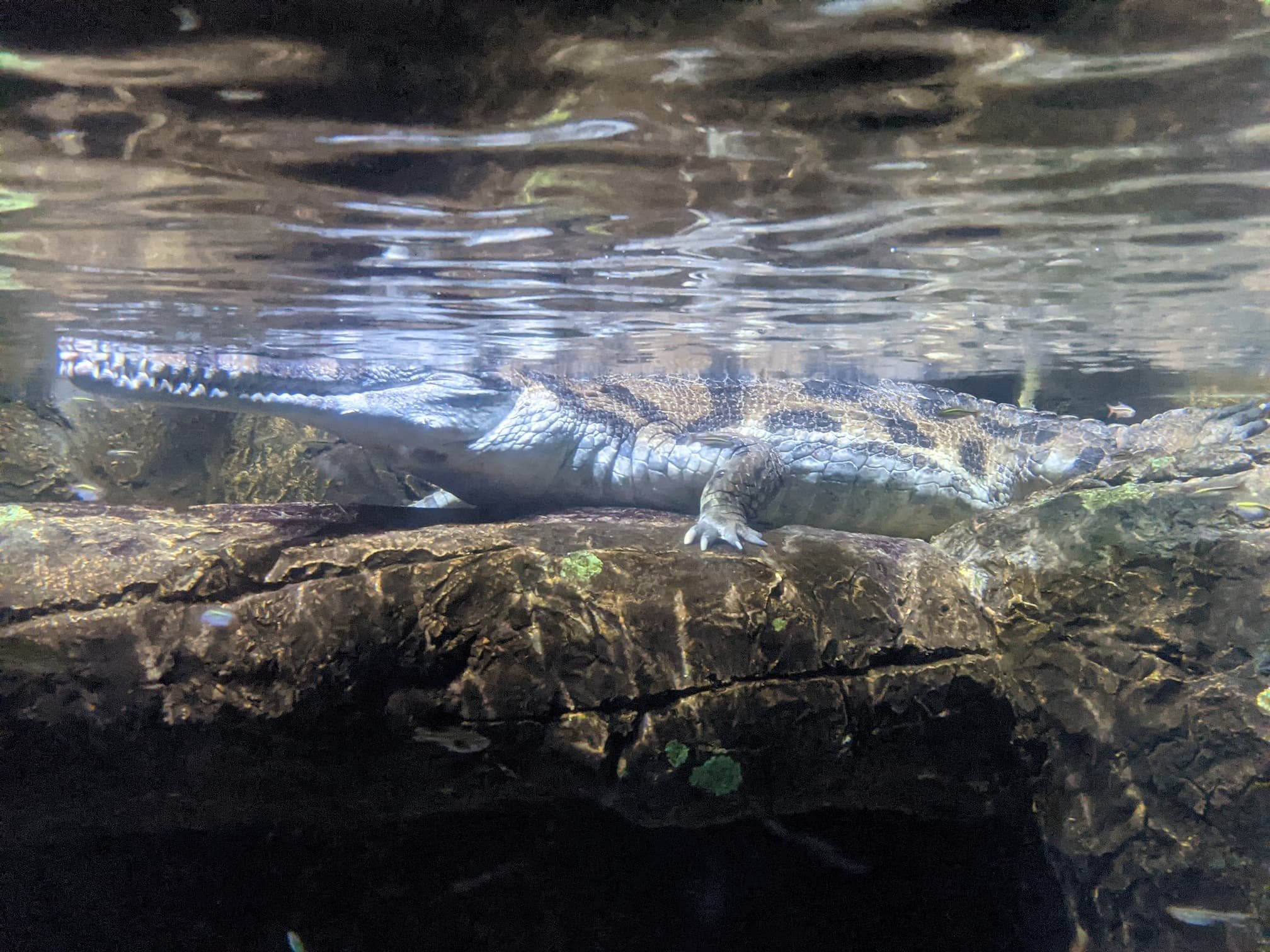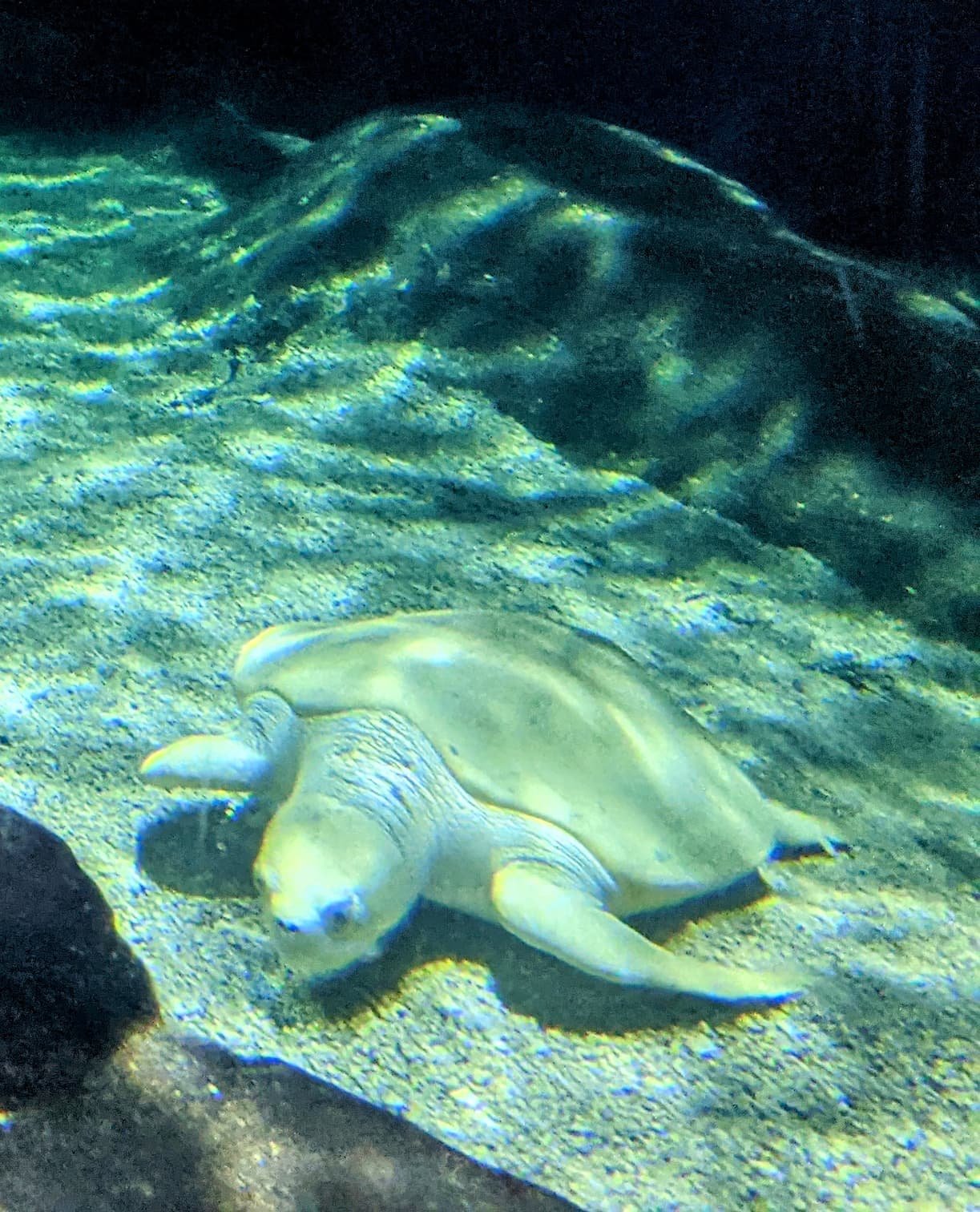Discovering the Controversy of Aquariums in Virginia Beach
This post may contain affiliate links where I earn a small commission when you make a purchase using the links at no additional cost to you.
Virginia Beach has a lot to offer visitors, but is the Virginia Aquarium and Marine Science Center a worthy competitor for your time?
Virginia Beach, VA
Drew and I spent the week before Halloween in Virginia Beach, a city which has pockets that exude ghost town vibes during October. In the humble opinion of a girl who spent the last 26 winters in Pennsylvania, though, the week here felt balmy and almost tempted me to take a dip in the nearby bay. This was the last week in our month long, self inflicted, challenge to camp for free, which is thoroughly documented here, so we stayed our week here at a members only campground called Indian Cove Campground through the generosity of a friend of a friend who had a yearly membership there. For Drew and I, who had spent the last few weeks boondocking, this stop felt lavish to the fullest extent. Our site sat a whopping five steps from the bay outlet, and the week was overflowing with activities which had Drew and I wondering at different times throughout the week, “should we get a seasonal site next year?”
“The Cove” was a great campground with plenty of waterfront campsites as you can clearly see from this picture.
Indian Cove Campground was a fabulous place to spend our first holiday on the road. There were costume contests, extensively decorated trailers, and trick-or-treating throughout the park which had a ratio of walking to candy payoff that was so small it had me wishing that I was 10 years old again. It was the perfect spot to spoil our oldest godson on his first Halloween without lockdowns, and with the thick layer of sugar that caked his cheeks by the time the sun had set, I deemed the night an established success.
We filled the rest of our days with kayak trips throughout the meandering waters and tall grasses of the Back Bay Wildlife Refuge which was a thoroughly relaxing way to start our mornings once we mastered the art of rowing without colliding paddles. With the beaches deserted, we allowed ourselves to be hypnotized by the rhythm of the crashing waves at Sandbridge Beach, a treatment which nearly put me to sleep before Drew tapped me on my shoulder to remind me that we had dinner to attend to.
It is easy to get lost in the wildlife refuge as there aren’t many landmarks within the tall grasses. It is beautiful, though, and is worth your time if you think you can keep your sense of direction.
To satisfy our obsession with all things decadent and salty, Margie and Ray’s served us up three different styles of crab (steamed crab legs, creamy crab soup, and crab cakes), none of which disappointed us in the slightest. This dinner was just barely usurped by the spectacular brunch of a vegetable eggs benedict atop gooey biscuits which we found at The Bee and the Biscuit. This trendy breakfast spot is popular, and all but famous for its biscuits, cinnamon rolls, and lattes, the last of which I treated myself to in order to complete my breakfast feast. I opted for the Cinnamon Toast Crunch Latte which tasted like childhood, only a bit soured by the bartender asking me if I was hungover whilst handing me the hot beverage. I was, indeed, not hungover, but perhaps I could use a tiny bit of concealer to hide the dark circles under my eyes that a sugar buzzed toddler had given me the night before.
Unless you get there early, The Bee and The Biscuit can get crowded quickly. Luckily, this 70s style RV is a great backdrop to enjoy while waiting for a table.
The Bad Reputation of Aquariums
The sugar buzzed toddler in question is our godson, Lukas, whose presence in Virginia Beach, and the approaching Halloween weekend, prompted this drive to the coast. It should go without saying for many of you, but as a newly indoctrinated pair of aunt and uncle, this little boy is growing up so fast that any amount of quality time we could obtain during this visit felt like Christmas had come early. So when Drew’s sister offered to let us take Lukas to the Virginia Aquarium and Marine Science Center, one of his favorite places to explore, I hastily agreed before I gave myself a moment to think. I then proceeded to sit back in my seat and grow more anxious by the second.
When I was a graduate student at Penn State University, I spent some time with Dr. Victoria Braithwaite, a researcher of Animal Behavior and Cognition. Her and I had many conversations about our ongoing projects, generally focusing on addressing questions centered around animal behavior. While my research revolved around birds, Victoria’s research centered on fish, particularly the negative impacts that today’s conventional fisheries can have on the fish who are reared in these often overpopulated and understimulating environments. She published the now famous book “Do Fish Feel Pain?” where she used scientific evidence to support her assertion that despite the lack of facial expressions and recognizable communication, that fish are intelligent and suffer when placed in the environment of fisheries that prioritize profit above animal welfare.
Victoria served a short while on my doctorate committee before she passed away from pancreatic cancer in 2019. Both her life and her career were cut far too short, but her legacy very much continues to thrive. She is a person I often think about because of her generosity to offer knowledge and insight to the budding researcher that I was at the time, and her empathy toward a phylum of animals that most people dismiss as being “just a fish”. Would I be letting Victoria down if I supported the aquarium?
At the time, I stood at the intersection of guilt and confusion, a spot which provides good company. It was 2013 when the documentary Blackfish entered into and won the Sundance Film Festival. The film discusses what they considered to be unethical treatment of the killer whale Tilikum who was held in captivity and trained to perform for crowds of people at SeaWorld. It also heavily discusses the potential negative consequences that come with the captivity of marine mammals. The movie was quickly sensationalized, decreasing the profits and attendance of not just SeaWorld, but aquariums and marine parks all over the globe as consumers became more conscious about the impacts that their support for such establishments could have on the animals who live there.
The main concern of aquarium critics is that animals here are held in stress-inducing environments with little to no benefit for conservation or education. With these critiques held in mind, I decided it best to spend my day at the Virginia Aquarium trying to uncover whether or not this center accomplishes more harm than good.
Virginia Aquarium and Marine Science Center
The concerns for animal welfare has been recognized with much greater validity in recent history than ever before. While I was working as a researcher, I can remember the frequent and vigorous inspections from the Institutional Animal Care and Use Committee (IACUC) that my lab went through to ensure that any animals in our facility were given adequate and proper care. So, before I even stepped foot in the aquarium, I found the aquarium equivalent under the name of the Association of Zoos and Aquariums (AZA). Driven by the mission of ensuring that zoos and aquariums operate under the highest standards of animal care and welfare, The Virginia Beach Aquarium and Marine Science Center is currently accredited by them through 2023. I recommend all lovers of things furry and scaly also verify the accreditation of any living animal park that you may be considering attending.
After parking at the aquarium, and escorting a babbling baby Lukas from his car seat, we headed towards the entrance, walking by the outdoor harbor seal exhibit in the process. Two seals swam upside-down laps in their enclosure to welcome us inside. Once through the doors, I scanned the aquarium map to orient myself to the exhibits and also to familiarize myself with the animals we were about to see. Among the Komodo dragons, sea turtles, jellyfish, lobsters, snakes, sting rays, sharks and other small fish species, a notable exemption from the list of residence were large marine mammals such as the killer whales featured in the Blackfish documentary.
Otherwise known as orcas, killer whales are massive animals that can swim an average of 40 miles a day. The tank size that would be able to facilitate this type of natural behavior in captivity is almost unimaginable and most certainly not a plausible option for any aquarium to implement. I found the absence of such marine mammals to be a refreshing surprise, and was my first indication that this aquarium was prioritizing the welfare of the animals that lived within its walls. In fact, the largest fish that the aquarium had was the zebra shark, a species which grows to an average of nine feet long and is known for its docile nature and slow movements which makes their comfort in captivity much more plausible.
The shark tank was one of Lukas’s favorite stops. He watched them swim lazily around the tank as he munched on a handful of animal crackers.
The room which gave me the highest degree of anxiety was the reptile room for reasons I feel are quite obvious. Is there really anything scarier than the thought of a pair of floating eyes above murky water slowly getting closer to you from an approaching crocodile? It was a bit of bad luck that this was one of Lukas’s favorite rooms, running back and forth between the Komodo dragon and the slender crocodile species called a Tomistoma. While this species was not one I was previously familiar with, a nearby sign about the animal caught my eye, and so I allowed Drew to play the latest game of “Catch the Toddler” as I did a bit of reading. The two Tomistomas who live at the aquarium, evidently named Ralph and Sommer, are a part of a species survival plan program facilitated at the aquarium. With their natural habitat located in remote areas of Malaysia, widespread habitat destruction to make room for palm oil plantations has lead to the near extinction of the species. To save them, the aquarium is working on a breeding and transfer plan to create healthy and diverse populations of the species with the overall goal to then release these animals into the wild where they can continue to repopulate their species in their native habitat. These types of programs occur in partnership with the AZA to help revitalize the populations of endangered species from all over the glove, saving them from the brink of extinction.
The aquarium is also working on numerous other conservation based projects including sea turtle hatchling releases and coral restoration projects that you can read more about here if you want to learn more.
Can you spot the Tomistoma in this picture?
It’s a bit easier to see this guy from beneath the water. This Tomistoma is one of two at the aquarium, and could help save the future of its species if the aquariums survival plan is succesful.
Not all of the animals at the Virginia Aquarium are there for such reasons of broader impact. While entering into the Light Tower Aquarium Room, we met a turtle named Greenie walking across the sandy bottom of the enclosure. Ironically named, Greenie has leucism, a genetic condition that leaves her shell and skin completely white. As a very friendly associate who was dressed up like Ms. Frizzle for the holiday weekend explained to us, Greenie was rescued as a hatchling by a researcher who was helping ensure the protection of a nest of newly hatched sea turtles. When the worker saw Greenie hatch with no pigmentation, he knew that her inability to camouflage herself among the seagrass would eliminate any chance of her survival. She was transported to the aquarium where she has lived for the past 35 years.
This is Greenie now, 35 years after being rescued and brought to the Virginia Aquarium.
To provide context in what a typical green turtle looks like, this is one of Greenie’s tank mates who has normal pigmentation.
As we approached the last few exhibits, I was beginning to feel that Lukas was actually feeding off of our energy, getting stronger through each passing moment that had Drew and I becoming weaker. We came upon the interactive eagle ray tank, an exhibit that made Lukas jump up and down with excitement, yet filled me with apprehension. This was perhaps the exhibit which I was most skeptical about from the beginning, for forcing animals to interact with humans does not seem like the most ethical choice for those wanting to prioritize animal welfare. Lukas, however, had no such reservations, eagerly asking to be picked up so that he could see the rays from an aerial view. As the room began to populate, an aquarium employee instructed the participants in the proper etiquette for interacting with the eagle rays, where instead of reaching down to force an interaction with them, we should leave our hands at the surface of the water and wait for the rays to swim by and initiate contact themselves. The employee went on to explain that small behavioral changes from aquarium guests such as this one can dramatically better the lives of the animals living at these centers while also working to minimize, if not eliminate, any stress that human presence has on them.
I am happy to report that the rays in this exhibit appeared healthy and active, providing me a little more reassurance that they were not being harmed by frequent contact with humans.
Drew, Lukas and I left the aquarium with levels of exhaustion that ran inversely parallel to our ages. For the rest of the day, Lukas would run over to his animal books, and point at anything with a fin while exclaiming, “fish!”
Here, Drew and Lukas look at a passing school of fish. Lukas frequently demanded to be picked up in order to see the fish better.
The oceans cover over 70% of the earth’s surface. They suffer from pollution, coral bleaching, changing temperatures, habitat loss and rapid rates of species extinction that threaten to collapse the ecosystems. The fight to rebalance the health of our oceans will continue throughout our generations and onto the younger ones. The rising class of marine biologists are for now just small children running through aquarium halls, becoming inspired by the animals they see there, and learning that the oceans are worth fighting for. In this effort, by watching Lukas’s eyes widen as he became mesmerized by the schools of fish which swam before him, I know that the Virginia Aquarium has undoubtedly succeeded.
Discover your Own Conclusion
I feel that it is important to recognize that what we see as an aquarium observer is only a slender slice of the whole pie. It is difficult to ascertain what happens behind the scenes at live animal parks, and it may be very different from the impression that we perceive as the average visitor. It is also true that many documentaries tend to be produced by individuals with strongly held beliefs and that the information presented in them can be misleading if not handled with unbiased integrity. Humans are impressionable. We can be emotionally manipulated quite easily and this is something that both skeptics and advocates for aquariums know quite well. It is up to us to be thoughtful consumers, to think critically about how we spend our dollars, and the organizations and companies that those dollars then support.
I believe that the scrutiny that zoos and aquariums have faced in recent years has forced them to strive toward a higher standard of animal care, and to be more transparent with their practices to the public who now demands it. Thinking back to some conversations with Victoria Braithwaite, I remember that it was never her stance to close marine centers like the one in Virginia Beach. What she stood for was that fish were intelligent, and worthy of cognitively stimulating environments with enough space to exercise whether they live in the wild, fisheries, aquariums, or anything in between. From my time there, the Virginia Aquarium and Marine Science Center seems to have done a great job at creating enclosures that mimic the natural habitat of the resident within it while also keeping those animal healthy and happy for the entirety of their life. It is not only a place that I would return, but one I would recommend you all to visit as well.
Do you know of a particularly wonderful zoo or aquarium that you would like to highlight? Share it with us and the other readers in the comment section! And don’t forget to subscribe to our newsletter so you never miss a science infused travel story.
Thank you for joining us at Discovery Detour, where the destination is always unknown.










